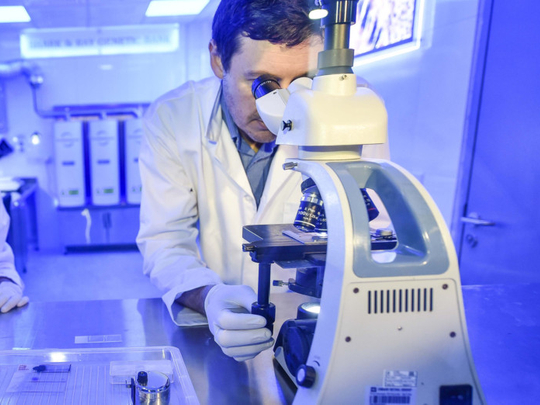
When you put the building blocks together you can always create something amazing. This time-tested lesson from a classic chemistry experiment, the results of which were first published 65 years ago this month, offers four useful lessons for continued scientific innovation, particularly in Dubai.
The 21st century Dubai is in itself a living experiment in innovation, and we have always looked to the past in designing the future.
In the autumn of 1952, a 22-year-old chemist named Stanley Miller made a rather outrageous proposition to his supervisor, Nobel laureate Harold Urey. Miller challenged that in their lab at the University of Chicago he would attempt to recreate the chemical soup of primordial earth, and then watch to see what transpired.
Miller’s apparatus was simple. Startlingly, it resembled a high-school experiment in more ways than one. To mimic the primordial soup of planet earth, he used two inter-connected sterile flasks containing water (for the primordial ocean) and methane, ammonia and hydrogen (to recreate the early atmosphere on earth). Miller and Urey heated the water to produce vapour, while firing sparks throughout the apparatus to simulate long-ago lightning.
Within a day, some unexpected things started to happen. An interesting pink solution appeared. One week later, Miller found that his flasks had spontaneously yielded 11 of the amino acids deemed essential raw materials for life on earth. (Later an analysis of Miller’s experiments using modern instruments and advanced techniques raised that figure to more than 20).
This experiment, while obviously not conclusive, has proved to be insightful for decades and continues to influence discussions of the mechanism by which life originated on earth some 3.5 billion to 3.8 billion years ago. People of different faiths will have divergent views on the nature of the creator who propelled this grand moment — when life was created on earth. However, there is a consensus in the scientific community that there was also an earth-bound process by which life evolved from its moment of creation.
Life was an innovation. Let us now consider the lessons the Miller-Urey experiment into this early innovation can impart to fast-track Dubai’s own industrial strategy.
n First, we need to remember that this was an experiment. There was a high chance of failure. Innovative ideas are not safe ideas, they are outside the norm, and the further outside the norm, the greater the risk.
Dubai has always been willing to take risks. An palm tree-shaped island, flying taxis, the world’s tallest building, a giant port built almost from scratch: Dubai is in many ways an experiment, and today we have sufficient proof that points to its successes to benchmark this city as a model for others that aspire to become the Dubai of Africa (Addis Ababa), and the Dubai of Central Asia (Astana).
n Second, the Miller-Urey experiment was not an expensive one. This lesson is especially valuable to Dubai during downturns in the business cycle — while money can help finance innovation, it is not fundamental to the process. Ideas are the most important currency of all.
Tangible rewards
While any researcher will admit that their project could use more funding, professor Magnus Gulbrandsen of the University of Oslo believes that such funding can actually be counterproductive. Innovative people find their motivation from within, and “expectations or promises of monetary or other tangible rewards in most cases will reduce the individual’s inner motivation for the activity.”
n Third, the key takeaway from within the experiment itself is that innovation is not just one thing, it is a combination of different elements, a sum of all parts. You need an ecosystem awaiting its spark, and you need a spark awaiting its ecosystem.
n Fourth and last, the innovative process must be able to sustain itself. The seed needs to spread roots and grow, it should be able to replicate.
That is the challenge for the long term. The key is to keep experimenting, like Miller and Urey did 65 years ago, regardless of success or failure. Today, the zeal to experiment and innovate is gathering momentum at free zones and innovation centres throughout Dubai.
This is how our city can build on our past innovations and shape future innovations, all the while developing a system that as it matures becomes self-sustaining, a system that is the driving force of life.
Marwan Abdulaziz Janahi is executive director of Dubai Science Park.









